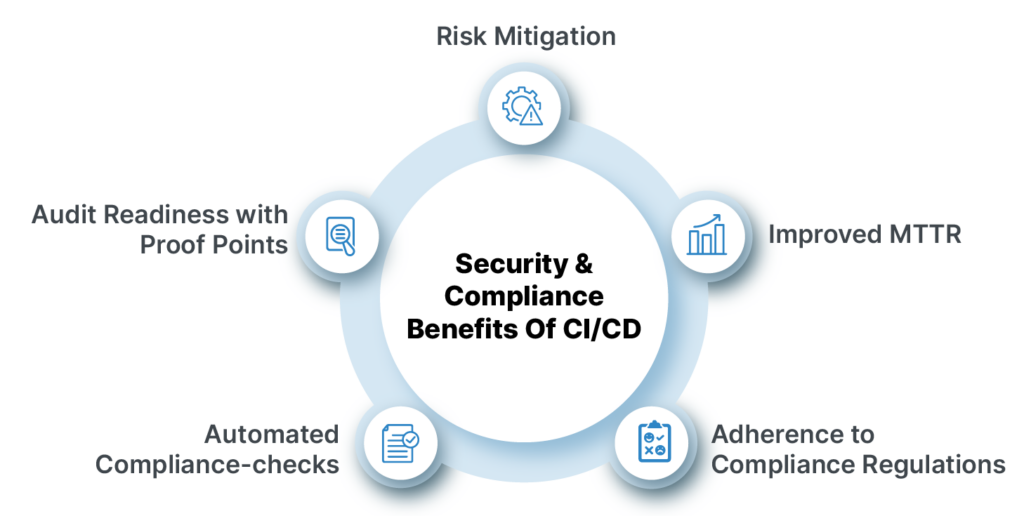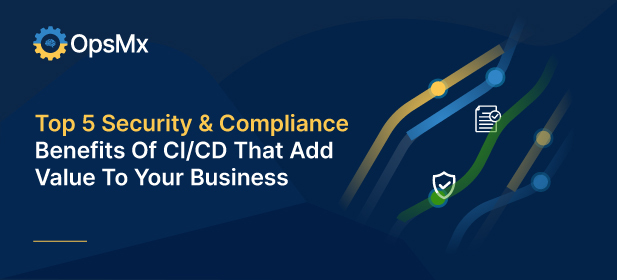In this blog, I’m addressing the top 5 benefits of CI/CD in the context of security and compliance. This is a must-read for everyone involved in a DevOps process, but especially AppSec and DevSecOps professionals.
But before getting into the benefits of a CI/CD process that any business is set to gain, I would first of all like to clarify what is CI/CD and why it should matter to you! However, if you feel you have a good understanding of these concepts, feel free to skip straight to the benefits section, where I list down the 5 benefits of an automated, secured, and compliant CI/CD process that indicates your applications have a healthy security posture.
What is CI/CD?
CI/CD stands for Continuous Integration and Continuous Deployment. It is a practice that helps automate multiple steps in the DevOps process. The primary aim of implementing a CI/CD process is to improve the efficiency and reliability of the overall software development and delivery process.

Let me briefly explain what CI and CD mean individually and the role they play in DevOps.
Continuous Integration (CI) explained
CI is a modern-day software development practice that enables multiple developers to simultaneously integrate their code changes into a shared repository, often multiple times a day. Prior to the widespread adoption of CI, code integration was a major pain point for teams since there were multiple developers committing code all together.
However, CI not only automates code integration but also kicks off automated ‘build’ and ‘test’ stages that verify code integrity. If the tests pass, then code changes are merged into the main branch of the codebase.
Continuous Deployment (CD) explained
CD is the next step in the process, which is responsible for automating infrastructure provisioning and the application release process. As opposed to manual deployment, which is tedious, time-consuming and error-prone, CD automatically deploys code changes to production without manual intervention, as long as all automated tests pass.
Thus, by implementing a robust CI/CD process, engineering teams can create a more efficient and reliable software development and delivery pipeline. I hope this helps you understand how CI/CD contributes to the overall agility and quality of the development process. If you’d like to learn more about CI/CD pipelines and the various stages that they comprise, then read this blog. Let me now proceed to the crux of this article, i.e., the benefits of CI/CD that indicate you have a healthy security posture.
Let me briefly explain what CI and CD mean individually and the role they play in DevOps.
Top 5 Security and Compliance Benefits of CI/CD

1. Early detection of vulnerabilities (Risk Mitigation)
Since developers integrate their code changes into a shared repository multiple times a day, each integration triggers an automated build and testing process. Most CI/CD pipelines and processes will include tools for security testing that scan the codebase for known vulnerabilities, security flaws, and potential threats.
Automated Security Analysis and Actionable Intelligence
Static Application Security Testing (SAST) and Dynamic Application Security Testing (DAST) are common techniques used for automated security testing. In particular, static code analysis is one such activity that checks the code for potential security vulnerabilities, coding standards violations, and other issues.
Thus, continuous code analysis being part of CI/CD ensures that security checks are an integral part of every code change, promoting a proactive approach to vulnerability detection and improving the overall security posture of applications.
2. Improved Mean Time To Resolution (MTTR)
MTTR measures how quickly an application recovers from failure or downtime. In other words, it establishes the standard time to fix a faulty feature and enables you to determine the time required for failure recovery.
In order to keep customers happy, MTTR should be as low as possible. Since CI/CD introduces small code changes into the codebase, fault isolations are easier to detect and less complicated to resolve. Faulty code could be the result of either buggy code or vulnerable packages in the codebase.
Fault Isolation and Vulnerability Tracing in Production
Vulnerability tracing helps identify, address, and prevent security vulnerabilities throughout the software development and deployment lifecycle. Integrating vulnerability tracing tools within your CI/CD workflows automates vulnerability detection and fault isolation, thus reducing MTTR in the event of a deployment failure.
3. Adherence to industry-specific regulations (e.g., HIPAA, HITRUST)
For many companies, complying with industry-specific or organization-specific regulations is mandatory. Implementing a CI/CD process can greatly contribute to adhering to regulations such as HIPAA (Health Insurance Portability and Accountability Act) and HITRUST (Health Information Trust). Here’s how a CI/CD process can contribute:
Policy-as-Code (PaC):
By implementing Policy-as-Code practices within the CI/CD workflow, you can stay in line with your policies. This involves codifying compliance policies and checks directly into the version control system, ensuring that compliance is verified automatically during the development lifecycle.
Secure Configuration Management:
The CI/CD processes can also include checks for secure configurations. This ensures that systems, databases, and other components are configured in accordance with regulatory requirements to protect sensitive data.
Data Encryption and Masking:
Data encryption and masking can be implemented as part of the CI/CD process, especially in environments where sensitive data is handled. This ensures that data is protected both during development and in production, meeting the encryption requirements of regulations like GDPR.
4. Automated compliance checks within the pipeline
You can integrate automated compliance checks into the CI/CD pipeline to ensure that code changes comply with regulatory requirements. This can include checks for data privacy, security, and other aspects specified by regulating bodies.
Policy as Code (PaC) for Policy Enforcement and Compliance Automation:
By codifying your organization’s policies into scripts or configuration files, PaC enables you to express policies in a format that can be versioned, reviewed, and applied automatically within the CI/CD pipeline. OpsMx’s Deployment Firewall is one way in which enterprises exercise PaC in their CI/CD pipeline.
By integrating such practices into your CI/CD pipeline, you can establish a systematic and automated approach to compliance checks. This not only improves the efficiency of compliance verification but also ensures that compliance is a continuous and integral part of the software development lifecycle.
5. Audit Readiness with Proof Points
In highly regulated industries such as Banking and Finance, policies and guidelines should not be violated. And proof of compliance needs to be displayed when regulators perform routine inspection and audits. With an automated CI/CD process, generating audit reports becomes much easier since automated tools can generate consistent and up-to-date documentation, reducing the manual effort required for audit reporting.
Audit Dashboards and Reports with Proof Points:
- By having compliance checks integrated into the pipeline, the audit report can include evidence of continuous compliance monitoring.
- In organizations where infrastructure configuration is closely monitored for performance optimization, automated tools within the CI/CD can assist by generating reports on the current state of environments, making it easier to verify compliance with specific configurations.
- Audit reports can also highlight anomalies or events by analyzing results from security monitoring, performance monitoring, and any other ongoing monitoring activities integrated with the CI/CD process.
Conclusion
Thus, the benefits of CI/CD are for all of you to see. Not only do the benefits of an automated CI/CD pipeline improve team efficiency, but they also compliment the security posture of your application. If you’re ready to implement a CI/CD pipeline to automate your deployments while ensuring security and compliance, talk to one of our CI/CD experts.

0 Comments